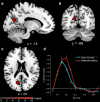Medial parietal cortex encodes perceived heading direction in humans
- PMID: 20881108
- PMCID: PMC6633521
- DOI: 10.1523/JNEUROSCI.3077-10.2010
Medial parietal cortex encodes perceived heading direction in humans
Abstract
The ability to encode and update representations of heading direction is crucial for successful navigation. In rats, head-direction cells located within the limbic system alter their firing rate in accordance with the animal's current heading. To date, however, the neural structures that underlie an allocentric or viewpoint-independent sense of direction in humans remain unknown. Here we used functional magnetic resonance imaging (fMRI) to measure neural adaptation to distinctive landmarks associated with one of four heading directions in a virtual environment. Our experiment consisted of two phases: a "learning phase," in which participants actively navigated the virtual maze; and a "test phase," in which participants viewed pairs of images from the maze while undergoing fMRI. We found that activity within the medial parietal cortex--specifically, Brodmann area 31--was modulated by learned heading, suggesting that this region contains neural populations involved in the encoding and retrieval of allocentric heading information in humans. These results are consistent with clinical case reports of patients with acquired lesions of medial posterior brain regions, who exhibit deficits in forming and recalling links between landmarks and directional information. Our findings also help to explain why navigation disturbances are commonly observed in patients with Alzheimer's disease, whose pathology typically includes the cortical region we have identified as being crucial for maintaining representations of heading direction.
Figures



References
-
- Aguirre GK, D'Esposito M. Topographic disorientation: a synthesis and taxonomy. Brain. 1999;122:1613–1628. - PubMed
-
- Baumann O, Chan E, Mattingley JB. Dissociable neural circuits for encoding and retrieval of object locations during active navigation in humans. Neuroimage. 2010;49:2816–2825. - PubMed
-
- Burgess N. Spatial memory: how egocentric and allocentric combine. Trends Cogn Sci. 2006;10:551–557. - PubMed
Publication types
MeSH terms
LinkOut - more resources
Full Text Sources
Other Literature Sources
Medical
